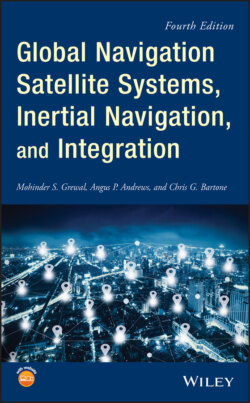Читать книгу Global Navigation Satellite Systems, Inertial Navigation, and Integration - Mohinder S. Grewal - Страница 92
3.3.3.2 Input–output Errors
ОглавлениеThe ideal sensor input–output function for rotation and acceleration sensors is linear and unbiased, meaning that the sensor output is zero when the sensor input is zero.
These are repeatable sensor output errors, unlike the zero‐mean random noise considered earlier. The same types of models apply to accelerometers and gyroscopes. Some of the more common types of sensor input–output errors are illustrated in Figure 3.5. These are listed for the specific panels:
1 bias, which is any nonzero sensor output when the input is zero;
2 scale factor error, usually due to manufacturing tolerances;
3 nonlinearity, which is present in most sensors to some degree;
4 scale factor sign asymmetry (often from mismatched push–pull amplifiers);
5 lock‐in, often due to mechanical stiction or (for ring laser gyroscopes) mirror backscatter; and
6 quantization error, inherent in all digitized systems.
Theoretically, one can recover the sensor input from the sensor output so long as the input–output relationship is known and invertible. Lock‐in (or “dead zone”) errors and quantization errors are the only ones shown with this problem. The cumulative effects of both types (lock‐in and quantization) often benefit from zero‐mean input noise or dithering. Also, not all digitization methods have equal cumulative effects. Cumulative quantization errors for sensors with frequency outputs are bounded by one‐half least significant bit (LSB) of the digitized output, but the variance of cumulative errors from independent sample‐to‐sample A/D conversion errors can grow linearly with time.
In inertial navigation, integration turns white noise into random walks.
